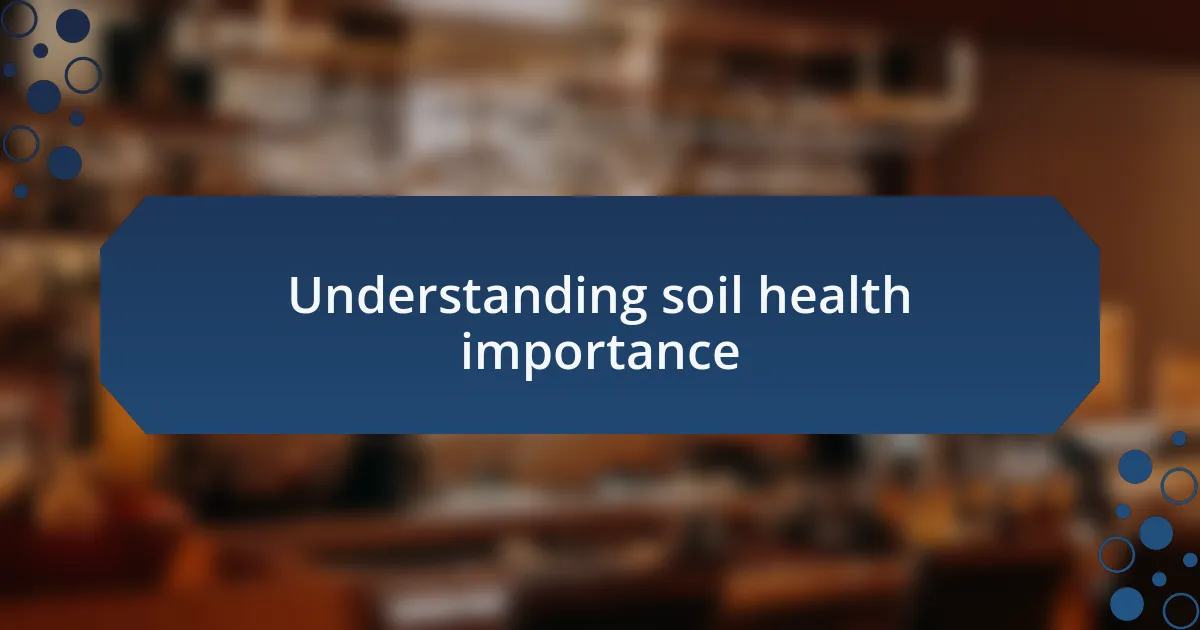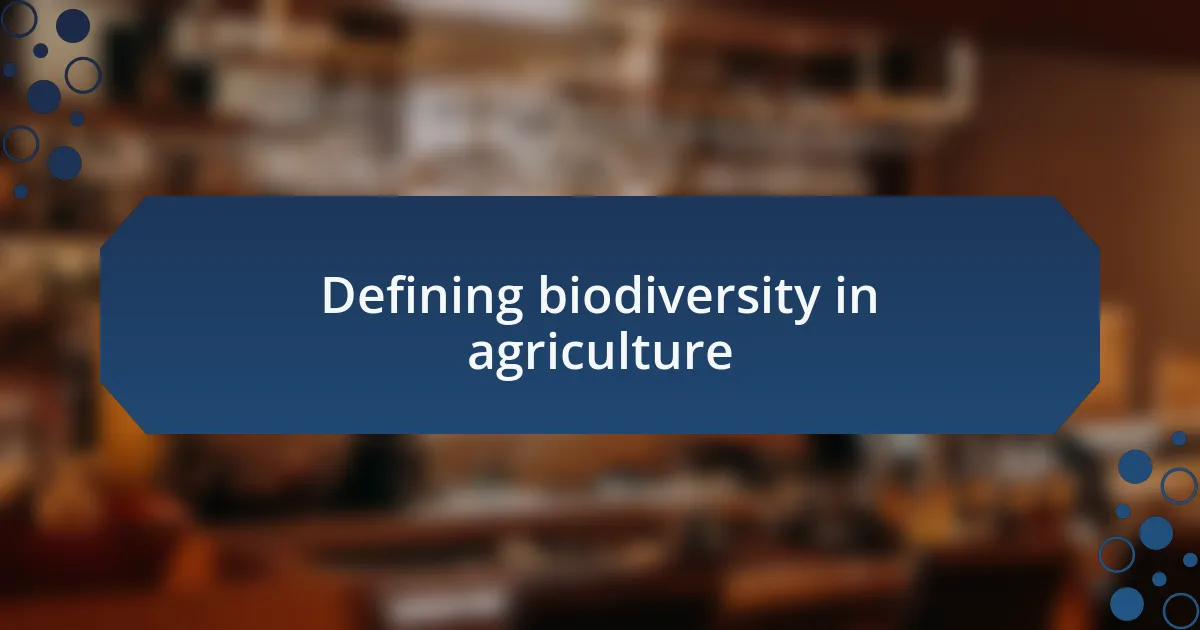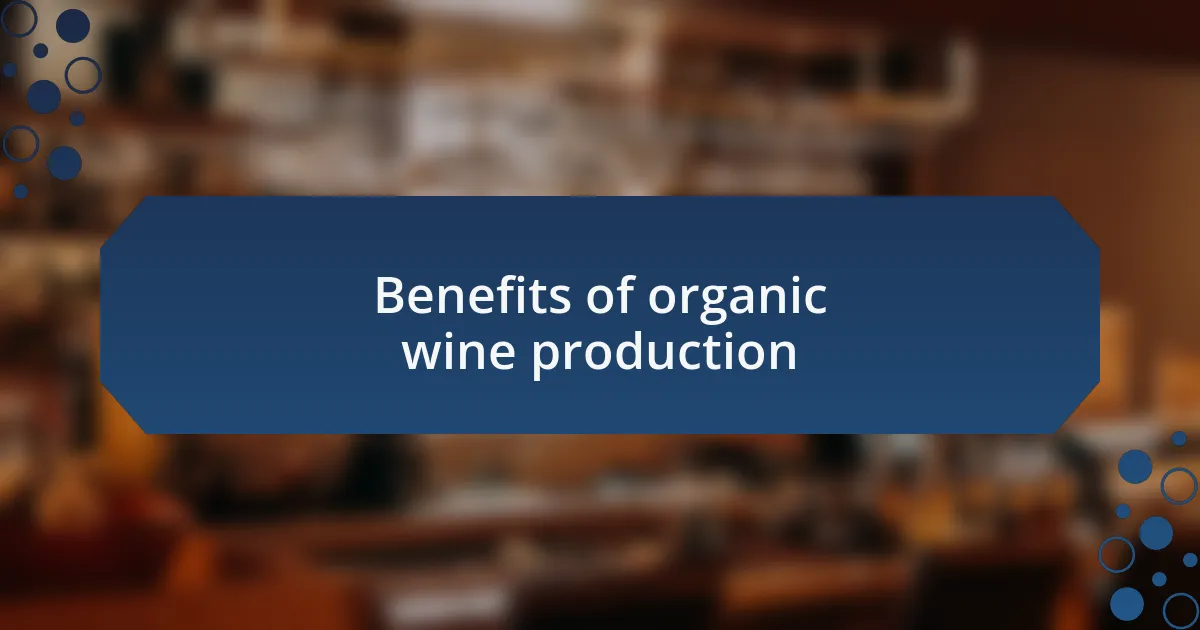Key takeaways:
- Healthy soil enhances plant growth and supports ecosystem biodiversity, crucial for organic wine production.
- Embracing biodiversity through companion planting and native species fosters natural pest control and enriches soil health.
- Organic practices improve grape flavor, promote a thriving ecosystem, and encourage wildlife to benefit vineyard health.
- Practical steps like crop rotation and creating wildlife habitats significantly enhance vineyard resilience and productivity.

Understanding soil health importance
Soil health is crucial not only for plant growth but also for the overall ecosystem. When I first started farming, it became evident that healthy soil means vibrant vines and more flavorful grapes. Have you ever tasted a wine that seemed to capture the essence of its environment? That’s the magic of thriving soil.
I often reflect on how soil acts as a living entity, supporting diverse microorganisms that break down organic matter and release nutrients. Just a few weeks ago, I performed a soil test on one of my vineyard plots, and I was amazed to find a thriving community of earthworms. This simple observation drove home the point that without such biodiversity, our efforts in organic wine production would be in vain.
Understanding soil health also means recognizing its role in climate resilience. When I think about lesser-known benefits, like its ability to retain water during droughts or filter pollutants, I feel a profound sense of responsibility. Isn’t it fascinating to think that by nurturing our soil, we’re also nurturing the planet?

Defining biodiversity in agriculture
Biodiversity in agriculture refers to the variety of life forms that inhabit agricultural landscapes, from plants and animals to microorganisms. I’ve realized that when I cultivate not just grapes, but also cover crops and flowers, I’m encouraging a vibrant ecosystem. Isn’t it remarkable how different species interact, creating a balance that ultimately boosts the health of my vineyard?
When I first integrated companion planting into my fields, I was taken aback by the array of insects that now visit my vines. Some of these tiny workers help control pests naturally, while others enrich the soil with essential nutrients. It’s a beautiful symbiosis that underscores how biodiversity contributes to a resilient farming system. Have you ever considered how diverse life can enhance your agricultural practices?
Ultimately, embracing biodiversity means fostering relationships among plants, animals, and the soil itself. This interconnectedness isn’t just good for production; it nurtures the land, ensuring its vitality for generations to come. Reflecting on this gives me a sense of purpose in my work. How can we overlook the magic of nature when we see its benefits daily?

Benefits of organic wine production
Organic wine production offers a rich array of benefits that impact both the vineyard and the broader environment. I can’t help but appreciate the unique flavors that emerge from organically grown grapes. Each bottle tells a story, reflecting the local terroir without the interference of synthetic chemicals. It’s a gratifying experience knowing that the wines I produce not only taste distinct but also support the health of the ecosystem.
One of the most significant perks is the boost to soil health. When I stopped using chemical fertilizers, I noticed an incredible transformation in my vineyard’s soil. The microbial life thrived, leading to better water retention and nutrient cycling. The roots of my vines reached deeper, allowing for resilience against drought. Have you ever thought about how much a healthy soil ecosystem can impact the quality of what we drink?
Moreover, organic practices help in preserving biodiversity, which is vital for a balanced environment. As I shifted to organic farming, I found that more bird species visited my vineyards. Their presence not only added beauty to my landscape but also aided in pest control. Isn’t it fascinating how fostering wildlife can directly benefit our crops while creating an inviting environment?

Practical steps for enhancing biodiversity
Enhancing biodiversity in my vineyard involves several practical steps that make a substantial difference. For starters, I’ve introduced native plants and flowers around the vineyard. This not only beautifies the landscape but also attracts beneficial insects, which play a crucial role in pollination and pest management. Have you ever noticed how vibrant a field of wildflowers can be? They really do draw in an array of wildlife!
In addition to planting native flora, I practice crop rotation and polyculture. By alternating the types of crops I cultivate, I keep soil nutrients balanced and prevent pest buildup. It’s a method that requires patience, but the outcome is a lush, resilient vineyard. I’ve found that watching this diversity grow is incredibly rewarding—each season brings a new set of surprises and interactions that enrich the ecosystem.
Lastly, I’ve found that creating habitats for wildlife, like installing birdhouses or leaving brush piles, benefits both the creatures and my vines. When I see birds nesting nearby, I realize how these small efforts culminate in a thriving environment. It’s a testament to how embracing biodiversity can genuinely enhance not just the vineyard’s productivity, but the overall health of the ecosystem. Have you thought about the potential impacts that even minor changes in your practices could foster?

Success stories from my vineyard
One of my proudest moments came when I observed a sharp increase in pollinator activity after introducing native wildflowers. The first time I saw a swarm of bees bustling around the newly planted blooms, I felt a rush of joy—it was like the vineyard had found its heartbeat again. Have you ever felt that magical connection when nature seems to respond to your efforts?
Another success story emerged when I rearranged my planting patterns to incorporate companion planting. I remember the day I noticed how the basil I had placed next to the grapevines grew exceptionally lush. Not only did it improve the flavor of my wine, but it also repelled pests naturally. It’s incredible how a simple change can lead to such a positive outcome; I was left wondering how many others could benefit from this approach.
Lastly, the presence of an owl box we installed last year has turned into a thrilling chapter in our vineyard’s story. Hearing the hoots echo through the vines at dusk not only brings a sense of wonder but also reassures me that my pest management strategy is working. Each time I see an owl swooping down, I can’t help but smile, realizing that these investments in biodiversity are truly paying off in ways I never anticipated. Have you considered how such small additions might transform your own farming practices?